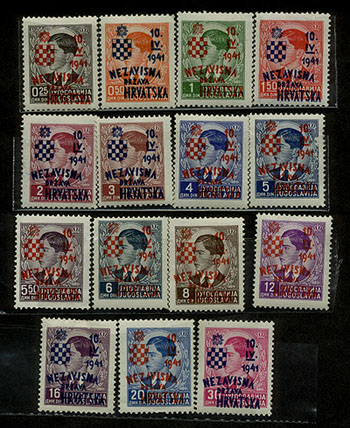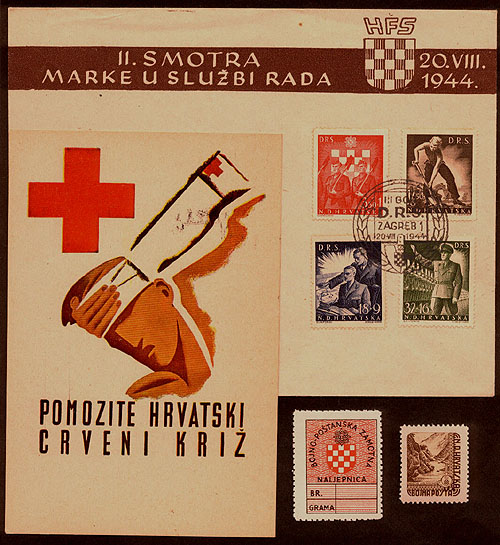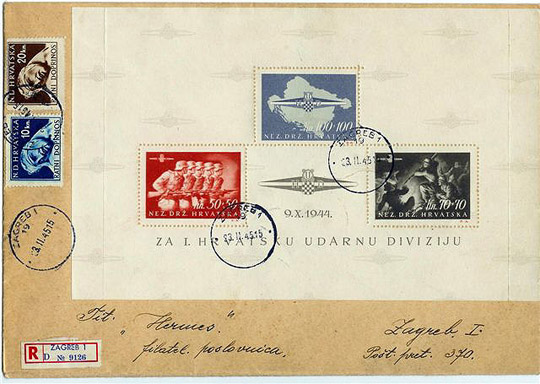Croatian
Army
|
Croatian
Army
|
|

Introduction
On 10 May 1941, 5000 sets of the Jusgolavia 1939 issues were overprinted.
These postage stamps were issued to honor the founding of the Croatian Armed Forces.
Croatia proclaimed its independence on 10 April 1941 under the leadership
of Dr. Ante Pavelic. Six days later the Croatian Home Defense
force was created and led under Field-Marshal Kvaternik. The
Croatian Home Defense Army was basically used as an occupational
force and to combat Tito's Partisans. In November 1941, the
Croatian Army was reorganized into three Region Corps, each
with two infantry divisions. Each division only had about 4000
men, so really it should be of brigade size.
|
|
The Croatian Regular Army
"Domobran"
In 1943, the Croatian
Army was referred as "Domobrani." The Domobrani or regular army
were mostly led by former Officers of the Royal Yugoslav Army.
Other specialized military formations were formed. In April
1942, the 1st Mountain Division was activated with a force of
17,000 men. Three Croatian Armored Corps of battalion strength
were formed and later by 1943 incorporated into the three Army
Region Corps.
Like the Italians who had their political Black
Shirts formations, the Croatians had the Ustaša Units ( Croatian Revolutionary Movement) , which
were established in early May 1941. By 1944 the Ustaša force
grew from 17,000 men in early 1941 to 76,000 men. In September
1941, the 1st Ustaša Regiment was formed in Sarajevo and commanded
by Major Jure Francetic. The dreaded Ustaša Regiment was commonly
referred as the Black Legion because all the men wore black
uniforms.
|
|

First Day Cover showing 3rd Anniverssary State Labor Service postal issues with
special cancel dated 20 August 1944. Next to it is a special Red Cross postcard
showing wounded soldier and nurse. Below on the left is a Military Parcel Stamp
released on 6 January 1945 in order to limit the amount of parcel post sent by military
personnel. Only two labels were issued to each soldier. The Parcel Stamp shown on your
bottom right was issued on 24 March 1945.
|
|
In August 1941, the Germans formed the 362nd Infantry
Regiment from recruits and former veterans of the Croatian Legion,
whom had participated in the battle of Stalingrad.
Please note
that the military and postal history of the Croatian Legion
shall be discussed in "LEGION-STAMPS."
In January 1943, the
373rd Infantry Division was formed and placed under German command.
The Croatians whom were part of these infantry divisions wore
German style uniforms and were trained by the Germans. The Germans
also had the Waffen-SS Mountain Division "Prinz Eugen," which
was composed of ethnic Germans from Croatia, Romania and the
Banat region.
In addition, the Germans formed the 13th SS Mountain
Division "Handschar" mostly composed of Muslims from Bosnia.
An attempt to form another SS Mountain division failed because
of the high desertion, it would have been officially designated
as the 23rd SS Mountain Division "Kama."
During the Italian
capitulation on 9 November 1943, the Croatian 369th and 373rd
Infantry Divisions as well as the SS Prinz Eugen Division participated
in the disarming of the Italians. By 17 August 1943, a third
German-Croatian division was formed it was designated the 392nd
Infantry Division. By 1944, the Croatian Infantry Divisions
participated in one of the last offensives in attempting to
capture Tito, who was Drvar, Central Bosnia.
By 20 March 1945,
Tito�s Partisans, 800,000 strong now as part of the Yugoslavia
National Army began a major offensive. By 15 May all Croatian
territory was now part of Yugoslavia. The majority of Croatians
who were in the military were either massacre by Tito�s Partisans
or sent to Concentration camps.
Croatian
Postal History
Croatians serving their country paid for postage. Letters
and postcards were mailed at regular post offices because there
were no official military post offices in existence. By the summer
of 1943, Croatian fieldpost offices were established.
On 12 August
1944, a fieldpost service was introduced for Croatian forces fighting
Tito's partisans. The field service, were handled by the Croatian
Post, Telephone and Telegraph. The fieldpost service applied their
own postal cancels "GLAVNA SABIRNA BOJNA POSTA," however most
covers have regular postal cancels where units were stationed.
All military mail was eventually collected at the main postal
center located in Zagreb.
All military covers were inspected and
censored by Croatian postal authorities. On 17 April 1943, special
field cards were printed. These cards bore three language descriptions:
Croatian, German and Italian. After Italy capitulated these cards
were printed only in Croatian and German. The printing was done
by the Croatian State Printing office, on off-white, bluish, greenish
and blue-rose cardboard type of paper. The card was divided in
two parts. On the right top part is the states coat-of-arms, the
Croatian inscription: "DOPISNICA ZA BOJNU POSTU" (post card for
fieldpost), and the German FELDPOSTKARTE. Below the inscription
are six lines for addresses. On the left side of the card the
sender's address. In Sept. 1943, all field mail to and from Croatia
was censored.
Concerning the postage stamps, on 10 May 1941, 15
Yugoslav stamps were overprinted with the Croatian shield, the
date of issue and the inscription "HRVATSKE" (Croatia). They were
sold twice the face value, the surtax was used to fund the Croatian
Army.
In 1943, three imperforate semi-postals honoring the Black
Legion were issued.
On 9 January 1945, a set commemorating the
Croatian Storm Division was issue. In addition a souvenir sheet
showing the three stamps were issued. These stamps were design
by Oto Antonini. The stamps, was printed by Tipografije, Ltd.
in Zagreb.
Beginning the year 1945, two military stamps were released,
in order to facilitate the parcel post of military personnel.
On 6 January 1945, a military parcel stamp was printed for weight
not exceeding 1kg. Printed in Zagreb showing a red/black color
of the state coat-of-arms. Each soldier was given two stamps a
month. On 24 March 1945, a parcel stamp designed by Prof. Vladimir
Kirin showing the valley of Neretva River by Jablanica, bottom
of inscription "BOJNA POSTA" (military post). Printed in Zagreb
on white paper, brown/yellow color, 100,000 issued.
|

Croatian
Storm Division Stamps
On 10 April 1944, a set of three postal values commemorating the Ustaša Militia "Black Legion" were issued. Pictured in the anniversary sheet is the notorious
Black Legion leader Major Jure Francetic, who is wearing the black Ustaša uniform. Below is a souvenir re-print sheet of the desirable so-called
Storm Division Set.
Also shown below are three Storm Division stamps.
The 50 + 50Kn,postal
value stamp shows five members of the division in the assault.
Each wears a German helmet and the Storm Division insignia over
his right breast pocket. However each soldier wears a different
type of uniform.
Beginning at the left, the first soldier wears
the uniform of the Ustaša Militia, identified as a Corporal.
The second soldier wears a regular Army uniform, identified
as a Corporal.
The third soldier who's rank cannot be identified
wears a naval uniform.
The fourth soldier is an Air Force Officer.
The last soldier is a former member of the State Labor Service.
The 70 + 70Kn showing a scene depicting Storm Division troops
spoiling an evening around the campfire for the enemy.
The 100
+ 100Kn, blue color, showing the divisions emblem superimposed
on a map of Croatia. The stamps have the division emblem in
the upper left corner.

An extremely rare Croatian register cover
with Storm Division sheet. This cover was mailed to Zagreb on 3 February 1945 (from the collection of
Ramon Boronda).
|
|
[ Front
Page ] [ Top ] [Previous
Page [Next Page]
|


